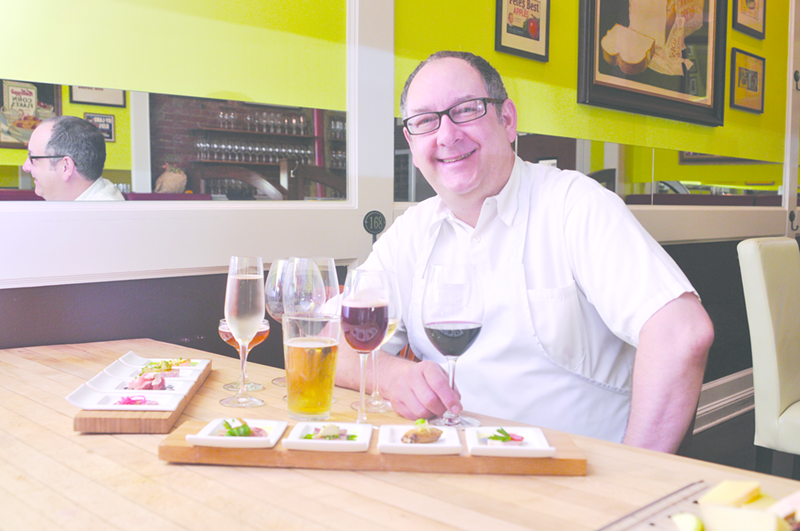P
airing food with any beverage is both a balancing act and a chemistry experiment; it is equal parts personal and scientific. Whether the beverage in question is a cocktail, beer, wine or something as simple as fruit juice, it all comes down to balance.
Chef Steven Geddes of downtown restaurant Local 127 is one of just more than 100 certified Master Sommeliers (the highest distinction a professional can attain in fine wine and beverage service) in the United States. The fact that Geddes is also a working chef is somewhat of a rarity in the culinary world, making him uniquely gifted in the art of pairing food and drink.
“I started in the restaurant business in the kitchen, so my first love was really for food,” Geddes says. “And wine to me is a food itself. … It’s consumable, we ingest it and it just happens to have some alcoholic content in it. Beverage is a sort of condiment to food, so food and beverage should be looked at in very similar fashions.”
Geddes knows the science behind pairings and pleasing the palate in and out, but honoring personal taste often takes precedence over that science, he says.
“It really becomes about building flavors to what your likes are,” Geddes says. “No two palates are the same, and our tongues’ makeup changes physiologically every day so, for me, pairing is a very personal thing. It’s about the individual’s experience. I tell people all the time, ‘You should eat what you like and drink what you like.’ ”
“It’s the same type of situation as different tastes in music, and that’s why pairing involves a balance of the personal and the scientific,” he continues.
Geddes shares his advanced sommelier ranking with another person in the Cincinnati area: Laura Landoll, a certified specialist of wine (CSW) and an advanced sommelier who is well on her way to earning her Master Sommelier diploma.
Landoll, who spent more than 20 years in the food and drink industry and now teaches “Sommelier Prep” and beverage management courses at Cincinnati State’s Midwest Culinary Institute, agrees that it’s hard to follow hard and fast rules when creating pairings. She says the culinary hopefuls of the Midwest Culinary Institute put their own palates to the test as they learn to pair.
“We will do component tastings with food and wine to show what certain wines will do with the certain components,” she says. “They are taught about the basic components of sweetness and sourness and about the complexity of tastes that make up both food and drink.”
According to Geddes, the general rule is that the beverage should be sweeter than the dish because the taste of food, a solid, lingers in your mouth longer than a beverage, a liquid. Pairing based on the food prevents what Geddes describes as “the toothpaste plus orange juice effect.”
“When we pair, we consider four basic elements: sweet, sour, salt and bitter,” Geddes says. “It’s all based on the chemistry of your palate and what its balancing factors are. … [The palate] picks up a variety of tastes. It picks up all of those salty, sour, sweet and bitter components.”
Though the idea of pairing is often associated with food and alcohol, it can apply to anything consumable, Geddes says; attempting to find balance and harmony between each of those elements is what gives pairing such complexity.
“A chef is trying to make something that is balanced and a winemaker or a beer maker or the cocktail maker has their own ideas for the balance of their beverage,” Geddes says. “Taking all of those components into account is what gives context as you begin to pair. Each pairing is a little chemistry experiment in and of itself.”
Regardless of how cuisine evolves, Landoll says she teaches her students that some pairings will always be in style.
“You still have some classical food and wine pairings that are wonderful such as a nice cabernet sauvignon, whether it is old world or new world, that is great with a strip steak,” She says. “Chardonnay will always work well with lobster bisque and bleu cheese with tawny port, and muscadet with mussels or chocolate with Banyuls — those are classics.”
A great pairing makes a meal fantastic and a bad pairing sometimes will leave you wondering if the food is good, but food and beverage pairings extend far beyond how they taste, Landoll says.
“I often tell folks knowing what you like to drink is the most important. And I have often said the best pairings are the friends and family with whom you share the food and drink. It is not fun to dine and drink alone.”
Wine and dine by following Chef Steven Geddes’ rules of thumb:
1. Stay away from really heavy wines or beverages.
2. Choose light- to medium-bodied wines with good acidity in their fruit.
3. Sparkling wines work well with almost everything.
4. It’s almost impossible to make German rieslings taste bad.
5. Beers and cocktails pair more easily than wines — it’s more difficult to throw them off balance.
6. Pinot noirs and lighter red bridals tend to work with food.
7. Stay away from really alcoholic or over-the-top wines, which tend to overpower the food.
8. If you have a really heavy food, like a big steak, go with a big red, but for most other composed dishes, go with lighter wines.
Laura Landoll will teach FUNDAMENTALS OF PAIRING FOOD AND WINE for Cincinnati State’s Creations Community Cooking Class series on Nov. 15. It is open to the Cincinnati community for an $85 fee. To learn more, visit culinary.cincinnatistate.edu.


